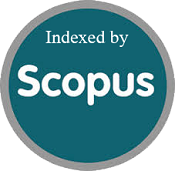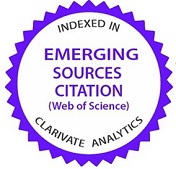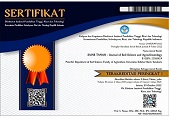Assessment of the ecological state and health of oil-contaminated Luvic Phaeozems Albic, Gleyic Albeluvisols, and Greyic Phaeozems after remediation by biochar
Abstract
Keywords
Full Text:
PDFReferences
Barakhov, A., Chernikova, N., Dudnikova, T., Barbashev, A., Sushkova, S., Mandzhieva, S., . . . Konstantinov, A. (2023). Role of sorbents in early growth of barley under copper and benzo(a)pyrene contaminated soils. Eurasian Journal of Soil Science, 12(1), 1-9. https://doi.org/10.18393/ejss.1177672
Burachevskaya, M. V., Bauer, T. y. V., Lobzenko, I. y. P., Gorovtsov, A. V., Vechkanov, E. M., Plotnikov, A. A., . . . Minkina, T. M. (2022). Influence of carbonaceous sorbents obtained from plant raw materials on the mobility of Zn ions in soil. Chemistry of plant raw material, 1. https://doi.org/10.14258/jcprm.20230111702
Caltabellotta, G., Iovino, M., & Bagarello, V. (2022). Intensity and persistence of water repellency at different soil moisture contents and depths after a forest wildfire. Journal of Hydrology and Hydromechanics, 70(4), 410-420. https://doi.org/10.2478/johh-2022-0031
Cherdakova, A. S., & Galchenko, S. V. (2020). Change of phytotoxicity of soils contaminated with oil products in the process of their microbiological remediation during the application of humic preparations. RUDN Journal of Ecology and Life Safety, 28(4), 336-348. https://doi.org/10.22363/2313-2310-2020-28-4-336-348
Cocârţă, D. M., Stoian, M. A., & Karademir, A. (2017). Crude Oil Contaminated Sites: Evaluation by Using Risk Assessment Approach. Sustainability, 9(8), 1365. https://doi.org/10.3390/su9081365
Dadenko, E. V., Kazeev, K. S., & Kolesnikov, S. I. (2021). Methods for determining the enzymatic activity of soils. Publishing House of the Southern Federal University, Rostov-on-Don.
Daoud, R., Kolesnikov, S., Kuzina, A., Kazeev, K. S., & Akimenko, Y. (2019). Development of regional maximum permissible concentrations of oil in the soils of arid ecosystems in the south of Russia. Ecology and Industry of Russia, 23(9), 66-70. https://doi.org/10.18412/1816-0395-2019-9-66-71
Das, A. J., Ambust, S., Singh, T., & Kumar, R. (2021). Biosurfactant assisted design treatments for remediation of petroleum contaminated soil and metabolomics based interactive study with Brassica nigra L. Environmental Challenges, 4, 100080. https://doi.org/10.1016/j.envc.2021.100080
Dekker, L. W. (1998). Moisture variability resulting from water repellency in Dutch soils [external PhD, WU, Landbouwuniversiteit Wageningen]. https://doi.org/10.18174/200090
Dike, C. C., Hakeem, I. G., Rani, A., Surapaneni, A., Khudur, L., Shah, K., & Ball, A. S. (2022). The co-application of biochar with bioremediation for the removal of petroleum hydrocarbons from contaminated soil. Science of The Total Environment, 849, 157753. https://doi.org/10.1016/j.scitotenv.2022.157753
Dike, C. C., Shahsavari, E., Surapaneni, A., Shah, K., & Ball, A. S. (2021). Can biochar be an effective and reliable biostimulating agent for the remediation of hydrocarbon-contaminated soils? Environment International, 154, 106553. https://doi.org/10.1016/j.envint.2021.106553
Ding, Y., Liu, Y., Liu, S., Li, Z., Tan, X., Huang, X., . . . Zheng, B. (2016). Biochar to improve soil fertility. A review. Agronomy for Sustainable Development, 36(2), 36. https://doi.org/10.1007/s13593-016-0372-z
dos Santos, J. J., & Maranho, L. T. (2018). Rhizospheric microorganisms as a solution for the recovery of soils contaminated by petroleum: A review. Journal of Environmental Management, 210, 104-113. https://doi.org/10.1016/j.jenvman.2018.01.015
Galstyan, A. S. (1978). Unification of methods for studying the activity of soil enzymes. Soil Science, 2, 107-114.
Gorovtsov, A. V., Minkina, T. M., Mandzhieva, S. S., Perelomov, L. V., Soja, G., Zamulina, I. V., . . . Yao, J. (2020). The mechanisms of biochar interactions with microorganisms in soil. Environmental Geochemistry and Health, 42(8), 2495-2518. https://doi.org/10.1007/s10653-019-00412-5
IUSS Working Group WRB. (2014). World Reference Base for Soil Resources. International soil classification system for naming soils and creating legends for soil maps. World Soil Resources Reports. FAO 106. https://openknowledge.fao.org/server/api/core/bitstreams/bcdecec7-f45f-4dc5-beb1-97022d29fab4/content
Kallas, E. V., & Maron, T. A. (2018). Land reclamation of saline soils and methods of their study: An educational and methodical manual. Publishing House of Tomsk State University.
Kamali, M., Sweygers, N., Al-Salem, S., Appels, L., Aminabhavi, T. M., & Dewil, R. (2022). Biochar for soil applications-sustainability aspects, challenges and future prospects. Chemical Engineering Journal, 428, 131189. https://doi.org/10.1016/j.cej.2021.131189
Karimullin, L. K., Petrov, A. M., & Vershinin, A. A. (2017). Biochemical activity of sod-podzolic soils in conditions of oil pollution. International Scientific and Practical Conference Sustainable Development of regions: experience, problems, prospects, Academy of Sciences of the Republic of Tatarstan, Kazan 16-17 November, 2017.
Kazeev, K. S., Kolesnikov, S. I., Akimenko, Y. V., & Dadenko, E. V. (2016). Methods of biodiagnostics of terrestrial ecosystems. Publishing House of the Southern Federal University, Rostov-on-Don.
Khaziev, F. H. (2018). Ecological connections of soil enzymatic activity. Ecobiotech, 1(2), 80-92.
Kong, L., Gao, Y., Zhou, Q., Zhao, X., & Sun, Z. (2018). Biochar accelerates PAHs biodegradation in petroleum-polluted soil by biostimulation strategy. Journal of Hazardous Materials, 343, 276-284. https://doi.org/10.1016/j.jhazmat.2017.09.040
Kumar, M., Xiong, X., Wan, Z., Sun, Y., Tsang, D. C. W., Gupta, J., . . . Ok, Y. S. (2020). Ball milling as a mechanochemical technology for fabrication of novel biochar nanomaterials. Bioresource Technology, 312, 123613. https://doi.org/10.1016/j.biortech.2020.123613
Liang, X., He, J., Zhang, F., Shen, Q., Wu, J., Young, I. M., . . . Hill, J. (2020). Healthy soils for sustainable food production and environmental quality. Frontiers of Agricultural Science and Engineering, 7(3), 347-355. https://doi.org/10.15302/J-FASE-2020339
Minkina, T. M., Barakhov, A. V., Bauer, T. V., Lobzenko, I. P., & Latsinnik, E. S. (2022). Efficiency of using carbonaceous and mineral sorbents in technogenically polluted zinc chernozem. Current Biotechnology, 1, 193-195. https://www.actbio-vsuet.ru/jour/article/view/369/368
Minnikova, T., Kolesnikov, S., Minin, N., Gorovtsov, A., Vasilchenko, N., & Chistyakov, V. (2023). The Influence of Remediation with Bacillus and Paenibacillus Strains and Biochar on the Biological Activity of Petroleum-Hydrocarbon-Contaminated Haplic Chernozem. Agriculture, 13(3), 719. https://doi.org/10.3390/agriculture13030719
Minnikova, T., Ruseva, A., & Kolesnikov, S. (2022). Assessment of Ecological State of Soils Contaminated by Petroleum Hydrocarbons after Bioremediation. Environmental Processes, 9(3), 49. https://doi.org/10.1007/s40710-022-00604-9
Minnikova, T. V., & Kolesnikov, S. I. (2025). Environmental assessment of biochar application for remediation of oil-contaminated soils under various economic uses. Journal of Mining Institute, 271, 84-94. https://pmi.spmi.ru/pmi/article/download/16293/16417
Mo, T., Jiang, D., Shi, D., Xu, S., Huang, X., & Huang, Z. (2022). Remediation mechanism of “double-resistant” bacteria—Sedum alfredii Hance on Pb- and Cd-contaminated soil. Ecological Processes, 11(1), 20. https://doi.org/10.1186/s13717-021-00347-9
Mukome, F. N. D., Buelow, M. C., Shang, J., Peng, J., Rodriguez, M., Mackay, D. M., . . . Parikh, S. J. (2020). Biochar amendment as a remediation strategy for surface soils impacted by crude oil. Environmental Pollution, 265, 115006. https://doi.org/10.1016/j.envpol.2020.115006
Nosova, M. V., Seredina, V. P., & Stovbunik, S. A. (2023). Assessment of soil changes causing contamination with crude oil and mineralized liquids in the Middle Ob region (Western Siberia). Ecosystem Transformation, 6(2 (20)), 64-73. https://doi.org/10.23859/estr-220718
Revina, S., Minnikova, T., Ruseva, A., Kolesnikov, S., & Kutasova, A. (2024). Catalase activity as a diagnostic indicator of the health of oil-contaminated soils after remediation. Environmental Monitoring and Assessment, 196(5), 449. https://doi.org/10.1007/s10661-024-12604-3
Rubel, R. I., Wei, L., Alanazi, S., Aldekhail, A., Cidreira, A. M., Yang, X., . . . Zhao, X. (2024). Biochar-compost-based controlled-release nitrogen fertilizer intended for an active microbial community. Frontiers of Agricultural Science and Engineering, 11(2). https://doi.org/10.15302/J-FASE-2024571
Ruseva, A., Minnikova, T., Kolesnikov, S., Revina, S., & Trushkov, A. (2023). Ecological State of Haplic Chernozem after Pollution by Oil at Different Levels and Remediation by Biochar. Sustainability, 15(18), 13375. https://doi.org/10.3390/su151813375
Ruseva, A., Minnikova, T., Kolesnikov, S., Trufanov, D., Minin, N., Revina, S., & Gayvoronsky, V. (2024). Assessment of the ecological state of haplic chernozem contaminated by oil, fuel oil and gasoline after remediation. Petroleum Research, 9(1), 155-164. https://doi.org/10.1016/j.ptlrs.2023.03.002
Sani, J. E., George, M., & and Musa, S. (2023). Physicochemical evaluation of coconut shell biochar remediation effect on crude oil contaminated soil. Cogent Engineering, 10(2), 2269659. https://doi.org/10.1080/23311916.2023.2269659
Shankar, S., Kansrajh, C., Dinesh, M. G., Satyan, R. S., Kiruthika, S., & Tharanipriya, A. (2014). Application of indigenous microbial consortia in bioremediation of oil-contaminated soils. International Journal of Environmental Science and Technology, 11(2), 367-376. https://doi.org/10.1007/s13762-013-0366-1
Susilowati, L. E., Sukartono, S., Akbar, M. F., Kusumo, B. H., Suriadi, A., Leksono, A. S., & Fahrudin, F. (2024). Assessing the synergistic effects of inorganic, organic, and biofertilizers on rhizosphere properties and yield of maize. Sains Tanah Journal of Soil Science and Agroclimatology, 21(1), 13. https://doi.org/10.20961/stjssa.v21i1.85373
Tinebra, I., Alagna, V., Iovino, M., & Bagarello, V. (2019). Comparing different application procedures of the water drop penetration time test to assess soil water repellency in a fire affected Sicilian area. CATENA, 177, 41-48. https://doi.org/10.1016/j.catena.2019.02.005
Wang, H., Lv, Y., Bao, J., Chen, Y., & Zhu, L. (2024). Petroleum-contaminated soil bioremediation and microbial community succession induced by application of co-pyrolysis biochar amendment: An investigation of performances and mechanisms. Journal of Hazardous Materials, 466, 133600. https://doi.org/10.1016/j.jhazmat.2024.133600
Wang, J., & Wang, S. (2019). Preparation, modification and environmental application of biochar: A review. Journal of Cleaner Production, 227, 1002-1022. https://doi.org/10.1016/j.jclepro.2019.04.282
Wang, L., Chen, L., Tsang, D. C. W., Kua, H. W., Yang, J., Ok, Y. S., . . . Poon, C. S. (2019). The roles of biochar as green admixture for sediment-based construction products. Cement and Concrete Composites, 104, 103348. https://doi.org/10.1016/j.cemconcomp.2019.103348
Wang, P., Liu, X., Wu, X., Xu, J., Dong, F., & Zheng, Y. (2018). Evaluation of biochars in reducing the bioavailability of flubendiamide in water/sediment using passive sampling with polyoxymethylene. Journal of Hazardous Materials, 344, 1000-1006. https://doi.org/10.1016/j.jhazmat.2017.12.003
Wei, Z., Wei, Y., Liu, Y., Niu, S., Xu, Y., Park, J.-H., & Wang, J. J. (2024). Biochar-based materials as remediation strategy in petroleum hydrocarbon-contaminated soil and water: Performances, mechanisms, and environmental impact. Journal of Environmental Sciences, 138, 350-372. https://doi.org/10.1016/j.jes.2023.04.008
Ye, S., Guangming, Z., Haipeng, W., Chang, Z., Jie, L., Juan, D., . . . and Cheng, M. (2017). Co-occurrence and interactions of pollutants, and their impacts on soil remediation—A review. Critical Reviews in Environmental Science and Technology, 47(16), 1528-1553. https://doi.org/10.1080/10643389.2017.1386951
Yin, D., Wang, X., Peng, B., Tan, C., & Ma, L. Q. (2017). Effect of biochar and Fe-biochar on Cd and As mobility and transfer in soil-rice system. Chemosphere, 186, 928-937. https://doi.org/10.1016/j.chemosphere.2017.07.126
Zahed, M. A., Salehi, S., Madadi, R., & Hejabi, F. (2021). Biochar as a sustainable product for remediation of petroleum contaminated soil. Current Research in Green and Sustainable Chemistry, 4, 100055. https://doi.org/10.1016/j.crgsc.2021.100055
Zainulgabidinov, E. R., Petrov, A. M., Ustybayeva, A. A., & Ignatiev, Y. A. (2024). Comparative analysis of analytical methods for the determination of allochthonous organic matter in oil-contaminated soils. Russian Journal of Applied Ecology, 1, 57-66. https://cyberleninka.ru/article/n/sravnitelnyy-analiz-analiticheskih-metodov-opredeleniya-allohtonnogo-organicheskogo-veschestva-neftezagryaznennyh-pochv
Zhang, Y., Yang, R., Si, X., Duan, X., & Quan, X. (2019). The adverse effect of biochar to aquatic algae- the role of free radicals. Environmental Pollution, 248, 429-437. https://doi.org/10.1016/j.envpol.2019.02.055
Zhu, X., Chen, B., Zhu, L., & Xing, B. (2017). Effects and mechanisms of biochar-microbe interactions in soil improvement and pollution remediation: A review. Environmental Pollution, 227, 98-115. https://doi.org/10.1016/j.envpol.2017.04.032
Refbacks
- There are currently no refbacks.











.png)





